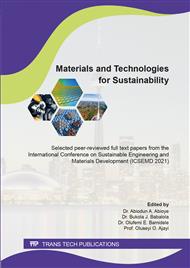[1]
L.C. Ekechukwu, Investigation of alternatives from local raw materials for power transformer liquid dielectric, Doctoral Research Thesis, Department Of Electrical Engineering, Faculty of Engineering, University of Nigeria Nsukka, Nigeria. October (2014).
Google Scholar
[2]
Palm oil – Our World in Data, Information on https//ourworldindata.org/.
Google Scholar
[3]
Step Up, Benefits of Bio-based Fluid ,: http://www.safertransformers.org/index.php.
Google Scholar
[4]
N. Rajanaidu, V. Rao, and B. K.Tan, Analysis of fatty acids composition in E. guineensis, E. Oleifera, their hybrids and its implications in breeding, in Oil Composition in Oil Palm, Malaysian Palm Oil Board, Malaysia. (1985) 81–94.
DOI: 10.19103/as.2017.0018.05
Google Scholar
[5]
RashmiSanghi, Article on Chemistry Behind The Life Of A Transformer. Resonance.(2003).
Google Scholar
[6]
D.M. Kazarnovsky, B.M. Tareev, I.D. Forsilova and L.I. Lyubimov, Testing of Electrical Insulating Materials,, (Mir Publishers Moscow), (1982).
Google Scholar
[7]
L.C. Lewand, Laboratory Evaluation of Several Synthetic and Agricultural-Based Dielectric Liquids in Proceedings of Sixty-Eighth Annual International Conference of Doble Clients, (2001).
Google Scholar
[8]
B. K. Tan, F. C. H. Oh, S. H. Ong, and K. G. Berger, Characteristics of Malaysian palm mid fractions PORIM Report PO. (34). 81(1981) 1–18.
Google Scholar
[9]
W. L.Siew, C.L. Chong, Y.A. Tan,S. Fairuzah, and M. Yassin, Identity characteristics of processed palm oils for export. PORIM Report PO(169), Malaysian Palm Oil Board, Kuala Lumpur (1990) 1–17.
Google Scholar
[10]
M. Tavares, and J.C. Barberio, Fatty acid composition of Brazilian palm oil, Proceedings of the Porim International Palm Oil Congress: Update and Vision in Chemistry and Technology, Kuala Lumpur.(1990) 328–332.
Google Scholar
[11]
N. Rajanaidu, A. Kushairi, M. Rafii, Din A. Mohd, I. Maizura, B. S. Jalani, Oil palm breeding and genetic resources, in Advances in Oil Palm Research, Vol. 1, Malaysian Palm Oil Board, Malaysia. (2000) 171–224.
DOI: 10.19103/as.2017.0018.05
Google Scholar
[12]
B. King, and I.Sibley, Authenticity of edible oils and fats. Part II Palm oil and palm fractions. The British Food Manufacturing Industries Research Association Report, No. 462, (1984) 1–36.
Google Scholar
[13]
S.C. Yap et al. (1991)Quantitative analysis of carotenes in the oil from different palm species. Elaeis, 3, p.369–378.
Google Scholar
[14]
B.S Jalani, S.C Cheah, N. Rajanaidu, and A. Darus (1997) Improvement of oil palm through breeding and biotechnology. J. Am. Oil Chem. Soc., 47, p.1451–1455.
DOI: 10.1007/s11746-997-0253-3
Google Scholar
[15]
SiewWai Lin, Palm Oil, Vegetable oils in food technology: Blackwell Publishing, CRC Press. (2002).
Google Scholar
[16]
M.T. Abdul Gapor, Content of vitamin E in Palm oil and its antioxidant activity, Palm Oil Devel. 12(1990) 25-27.
Google Scholar
[17]
M.T. Abdul Gapor, K. G. Berger, T. Hashimoto, K. Tanabe, H. Mamuro and M. Yamoka, Effects of processing on the content and composition of tocopherols and tocotrienols in palm oil, in Proceedings of Int. Conf. on Palm Oil Product Technology in the Eighties', Kuala Lumpur, organised by PORIM/ISP, 1981, p.145–156.
DOI: 10.5650/jos1956.30.590
Google Scholar


